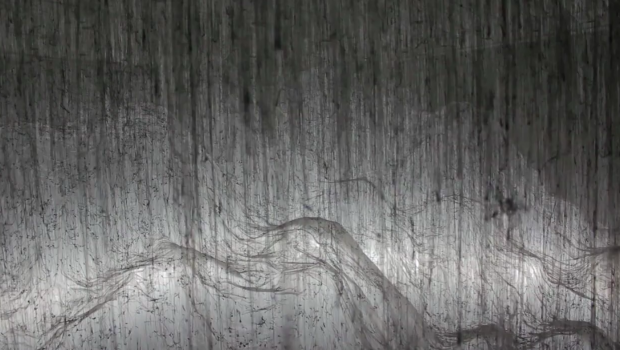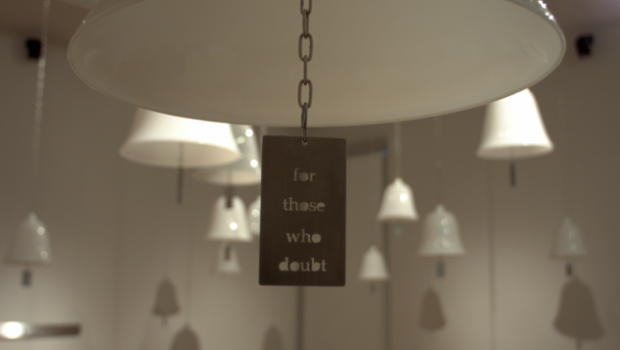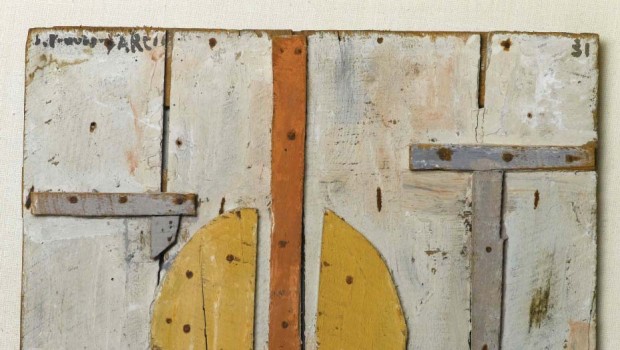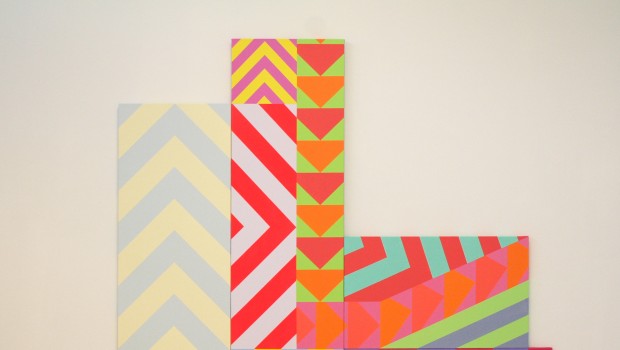Reversing Sculpture
Escultura Inversa
Nakamura Fumiko *
The fluorescent coating gives off a chilly light. The electric fan moans quietly. The glue hangs in the air. The polyethylene plastic sheet sways lightly. Onishi Yasuaki combines regular tools and electrical appliances in their original form to create large, three-dimensional works that exceed human scale. Sometimes a vinyl sheet catches the wind and rises up in a pure white space; other times, shiny, fluorescent-colored string expands and contracts in the darkness. Onishi’s works softly fill an exhibition space for a set period of time, and are later dismantled without a trace.
Despite Onishi’s use of a fragile and hypothetical means of expression, the overall work maintains a cohesive power that verges on spectacle without ever becoming disjointed. This is because the things he creates are unquestionably “sculptures.” But in creating his works according to modern sculptural concepts, it might look as if Onishi has deliberately tried to distort them.
In fact, in gazing at his work, one realizes that Onishi has reinterpreted the essential concepts of modern sculpture, such as volume, masse, movement, and form, according to his own unique approach. For example, the physical volume of a work may not be endowed with masse because the interior of an object is hollow. In addition, as Onishi makes use of things like electric fans and model-train motors, he instills a sense of movement in his work in a very direct way. This simple, mechanical method, however, seems to imbue it with a clear sense of indifference. On the other hand, I would also like to mention a series of works that makes use of extremely light materials, which fluctuate by picking up vibrations in the air. With this approach, one might say Onishi is attempting to discard the peculiarly solid and permanent quality of sculpture and replace movement with actual movement. Moreover, the form of the sculpture is created through a reciprocal relationship with its surroundings and a dynamic system – in and of itself, it lacks any definite substance. With each instant or point of perception, the form is renewed.Thus, Onishi adopts classical sculptural concepts one after another and interprets them according to his position to give rise to something – which might be seen as a phenomenon or presence – that would normally be difficult to create. As he moves back and forth between a sense of tension and relaxation, floating and gravity, he captures a unique atmosphere that gradually comes to life.
Titled reverse of volume, Onishi’s work in this exhibition establishes a void. By suspending the glue and polyethylene plastic sheet from the ceiling, the artist draws our attention to the empty space and heightens the intensity of the void at its center. Normally, in the process of casting a bronze statue, the undulations of the work are the inverse of the mold used to make it, but is Onishi perhaps attempting to cast the entire exhibition space here? And is it perhaps we the viewers who are being poured into the temporary mold? The title of the work refers to the inversion of substance and void, but Onishi seems to be upending nothing less than sculptural concepts as we know them. What exactly is he hoping to discover through these two- and three-fold transitions?
*Nakamura Fumiko is the Onishi Yasuaki Aichi Prefectural Museum of Art Curator
Traducido al español por David Medina Portillo
La manta fluorescente emite una luz fría. El ventilador eléctrico gime silenciosamente. El pegamento cuelga del aire. La tela de polietileno se balancea ligeramente. Onishi Yasuaki combina instrumentos habituales y aparatos eléctricos en una forma original de crear obras tridimensionales que exceden la escala humana. A veces una manta de vinilo se expone al viento elevándose en un espacio blanco y puro; en otras, una cuerda fluorescente y colorida se expande y contrae en la oscuridad. Las obras de Onishi ocupan delicadamente el espacio de exposición durante un periodo fijo y, después, son desmontadas sin dejar rastro.
A pesar del empleo de un medio de expresión frágil e incierto, el conjunto de la obra de Onishi mantiene un poder cohesivo que bordea lo especular sin desarticularse nunca. Esto es así porque las cosas que crea son “esculturas” pese a que en su proceso de trabajo, y según conceptos modernos, podría parecer que Onishi ha tratado de deformarlos deliberadamente.
De hecho, en la contemplación de su obra uno advierte que Onishi ha reinterpretado –adaptándolos a sus necesidades– conceptos esenciales de la escultura moderna como volumen, masa, movimiento y forma. Por ejemplo, la dimensión física de una obra no puede estar sustentada por la masa ya que el interior del objeto es hueco. Asimismo, Onishi hace uso de materiales tales como ventiladores eléctricos o motores de trenes de modelaje proyectando a su obra un sentido de movimiento muy específico. Sin embargo, este método simple y mecánico parece impregnarla de un claro sentido de neutralidad. Por otra parte, no hay que dejar de mencionar su serie de obras que hacen uso de materiales extremadamente ligeros, los cuales ondean como captando las vibraciones del aire. Desde esta óptica, podría decirse que Onishi intenta desprenderse de la solidez e imperturbabilidad de la escultura reemplazando la imitación del movimiento con el movimiento real. Asimismo, en su trabajo la “forma” de la escultura se crea mediante una relación recíproca con el entorno y un sistema dinámico en y por sí mismo carente de cualquier sustancia definida. A cada instante o desde cualquier punto de observación y percepción, la forma se renueva. Así, Onishi adopta conceptos clásicos de la escultura reinterpretándolos para dar lugar a algo que podría ser visto como un fenómeno o una presencia que, normalmente, sería difícil crear. Dado que se mueve hacia adelante y hacia atrás, entre la tensión y la relajación o flotando y gravitando, el artista captura una atmósfera única que, gradualmente, cobra vida.
Bajo el título Reverse of Volume, el trabajo Onishi en esta exposición delimita un vacío. Al suspender el pegamento y el polietileno en el techo, el artista llama nuestra atención sobre el espacio desocupado e incrementa la intensidad de esa ausencia fundamental. En el proceso de fundir una estatua de bronce, las ondulaciones de la obra son inversas a los moldes utilizados. Sin embargo, ¿Onishi ha tratado de moldear aquí el espacio de exposición entero? ¿O quizá nosotros, los espectadores, hemos sido vertidos en un molde temporal? El título de la obra se refiere a la inversión de una sustancia y del vacío, aunque Onishi parece estar dando un vuelco más bien a los conceptos escultóricos tal y como los conocemos, nada menos. ¿Qué es exactamente lo que él espera descubrir a través de estas plegadas ondulaciones?
* Nakamura Fumiko es curador del Aichi Prefectural Museum of Art










